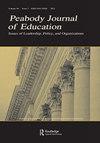“We Don’t Teach Critical Race Theory Here”: A Sentiment Analysis of K-12 School and District Social Media Statements
Q2 Social Sciences
引用次数: 0
Abstract
ABSTRACTConservative activism around the purported influence of Critical Race Theory (CRT) on K-12 education has swept the country in recent years. While others have documented the sources of these messages, how school districts have responded to these critiques has not yet been investigated. Drawing on research on how social media algorithms elevate polarizing information and activate emotions, we analyze public social media posts on school/district Facebook pages mentioning the phrase “critical race” to examine how educators address the claim of teaching CRT and how the local community responds. We use sentiment analysis to examine the emotions of these posts and how they are distributed across states. We also explore the sentiment of subsequent community reactions reflected in the comments of each post, including negative emotions such as anger and fear, and positive emotions such as trust. This study has implications for how school districts can help to stop cycles of fearful rhetoric and engage with stakeholders in ways that unite a school community around shared priorities. Disclosure statementNo potential conflict of interest was reported by the authors.Notes1 We realized that querying “CRT” yielded greater false positives in the form of posts that were not about “Critical Race Theory” but about “classroom reduction teachers” or televisions with “cathode ray tubes” being allowed in school electronic waste drives. Similarly, querying “Critical Race Theory” did not yield an appreciable increase in relevant posts, while requiring the word “theory” as part of the query resulted in some false negatives in which relevant posts were excluded.2 Demographic information and other district statistics for both Westfield, MA and Springboro, OH are from the National Center for Education Statistics accessed in June 2022.Additional informationNotes on contributorsEmily M. HodgeEmily M. Hodge is an associate professor of educational leadership at Montclair State University. Her research uses qualitative methods and social network analysis to understand curriculum politics and the intended and unintended consequences of education policy.Joshua M. RosenbergJoshua M. Rosenberg is an associate professor of STEM Education at the University of Tennessee, Knoxville. His interests are at the intersection of data science and education, including the application of data science methods in educational research contexts, and supporting K-12 students to work with data as a part of their learning.Francesca A. LópezFrancesca A. López is the Waterbury Chair in Equity Pedagogy at Penn State University. The overarching goal of her program of research is to inform policymakers, school leaders, and teacher educators about policies and classroom practices that can mitigate racial/ethnic inequality and social stratification.“我们这里不教批判种族理论”:对K-12学校和地区社交媒体声明的情绪分析
摘要近年来,围绕批判种族理论(CRT)对K-12教育影响的保守主义运动席卷了全国。虽然其他人已经记录了这些信息的来源,但学区如何回应这些批评尚未得到调查。根据对社交媒体算法如何提升两极分化信息和激活情绪的研究,我们分析了学校/学区Facebook页面上提到“关键种族”一词的公共社交媒体帖子,以研究教育工作者如何应对教授CRT的主张以及当地社区如何回应。我们使用情绪分析来检查这些帖子的情绪以及它们在各州之间的分布情况。我们还探讨了每个帖子评论中反映的后续社区反应的情绪,包括愤怒和恐惧等负面情绪,以及信任等积极情绪。这项研究对学区如何帮助停止可怕言论的循环,并以围绕共同优先事项团结学校社区的方式与利益相关者接触具有重要意义。披露声明作者未报告潜在的利益冲突。注1我们意识到,查询“CRT”会产生更多的误报,这些误报不是关于“批判种族理论”,而是关于“课堂减员教师”或学校电子废物处理站允许使用带有“阴极射线管”的电视。同样,查询“批判种族理论”并没有产生相关职位的明显增加,而要求“理论”一词作为查询的一部分导致一些假否定,其中相关职位被排除在外马萨诸塞州韦斯特菲尔德和俄亥俄州斯普林伯勒的人口统计信息和其他地区统计数据来自2022年6月访问的国家教育统计中心。作者简介:emily M. Hodge,蒙特克莱尔州立大学教育领导学副教授。她的研究使用定性方法和社会网络分析来理解课程政治以及教育政策有意和无意的后果。Joshua M. Rosenberg,美国田纳西大学诺克斯维尔分校STEM教育副教授。他的兴趣是数据科学和教育的交叉,包括数据科学方法在教育研究环境中的应用,以及支持K-12学生将数据作为学习的一部分。Francesca A. LópezFrancesca A. López是宾夕法尼亚州立大学沃特伯里公平教育学教授。她的研究项目的总体目标是告知政策制定者、学校领导和教师教育工作者有关政策和课堂实践,可以减轻种族/民族不平等和社会分层。
本文章由计算机程序翻译,如有差异,请以英文原文为准。
求助全文
约1分钟内获得全文
求助全文
来源期刊

Peabody Journal of Education
Social Sciences-Education
CiteScore
2.20
自引率
0.00%
发文量
43
期刊介绍:
Peabody Journal of Education (PJE) publishes quarterly symposia in the broad area of education, including but not limited to topics related to formal institutions serving students in early childhood, pre-school, primary, elementary, intermediate, secondary, post-secondary, and tertiary education. The scope of the journal includes special kinds of educational institutions, such as those providing vocational training or the schooling for students with disabilities. PJE also welcomes manuscript submissions that concentrate on informal education dynamics, those outside the immediate framework of institutions, and education matters that are important to nations outside the United States.
 求助内容:
求助内容: 应助结果提醒方式:
应助结果提醒方式:


